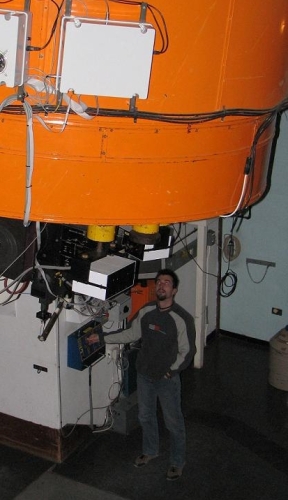Menu:
start CV work publications travel Solaris links contact FAQ

Copyright Krzysztof Helminiak, 2007-2016 ©

my research:
Binaries
Many stars in the Universe have their companions, which are bounded to them by gravitational forces. We call those systems binaries, or multiples, if there are more components. Stellar pairs of different kinds are unique laboratories, which give us an ability to check our theories about formation and evolution of stars, dynamics, accretion, relativity theory, Galaxy evolution and many others.
Eclipsing binaries
 In those objects stars eclipse each other, during the orbital motion. We see such an eclipse as a decrease in the brighntess of the system, which repeats periodically. Additionally, we can measure radial velocities of both components. From the shape, depth and timescale of the eclipse, and the character and amplitude of radial velocity changes, we can derive most of system's parameters. In particular: orbital parameters, masses and radii of both components, their temperatures and luminosities. This information is used to calculate the age of the system, distance, or test our theories of stellar evolution.
In those objects stars eclipse each other, during the orbital motion. We see such an eclipse as a decrease in the brighntess of the system, which repeats periodically. Additionally, we can measure radial velocities of both components. From the shape, depth and timescale of the eclipse, and the character and amplitude of radial velocity changes, we can derive most of system's parameters. In particular: orbital parameters, masses and radii of both components, their temperatures and luminosities. This information is used to calculate the age of the system, distance, or test our theories of stellar evolution.
In my work I mainly observe such systems, make their models and calculate previously mentioned parameters. I lead an observational project called Comprehensive Research with Echelles on the Most interesting Eclipsing binaries (CREME). In this project we observe a large number of objects and pick up the interesing ones - the creme de la creme of eclipsing pairs. For the modelling I use the JKT package, based on the EBOP code, and PHOEBE software, based on the Wilson-Deviney code. I am espiecially interested in rare, and poorly studied classes of detached eclipsing binaries.
For the VVV project I used detached eclipsing binaries to trace the structure of the Galaxy - its spiral arms and bulge. For this research I used the DEBiL and MECI codes.
Planets in binaries
Despite there are thousands of exoplanets known, only a small fraction of them is hosted by binaries or multiples. Is it only an effect of the lack of apropriate methods, or simply planets in binaries are rare, we don't know that. For sure, formation of those planets and the dynamics of planetary systems with many suns is interesting and complicated.
Currently I am involved in a program aimed to search for planets around eclipsing binaries with two methods: precise radial velocity measurements and eclipse timing. The project is called Solaris, and bases on very precise radial velocities and measuring the exact moments of brightness minima.
In the past in my research on visual binaries, I was checking if we can make astrometry precisely enough, to detect the influence of an exoplanet on star's movement. Well... we can :)
Visual binaries and high-resolution imaging
We call that binaries which components can be separated on pictures or in interferometric observations. Then, we can make astrometry (measure positions) and calculate relative orbits. Additionally, after radial velocities measurements, we can calculate orbial elements and masses of both components. We can also estimate the distance to the system.
In such work it is important to reach the angular resolution as high as possible. Advanced optical devices, called adaptive optics (AO) systems, allow us to reached the sharpest images possible to get from the ground. This is necessary to see separatelly two stars that are very close to each other, or to look for a faint companion to a star. Such companion can be another star, a brown dwarf, or a planet. For the SEEDS project I was analyisng a case of a small companion that first showed up in radial velocities, but was not found on images until the SEEDS observations. Possibility of combining radial velocity and imaging data for the same objects opens a new chapter in brown dwarf and exoplanet exploration.
I used to work on calculating masses and orbits on the basis of interferometric observations from PTI and VLTI combined wit radial velocities. I was also working on precise astrometry of visual binaries on CCD frames usung adaptive optics.

